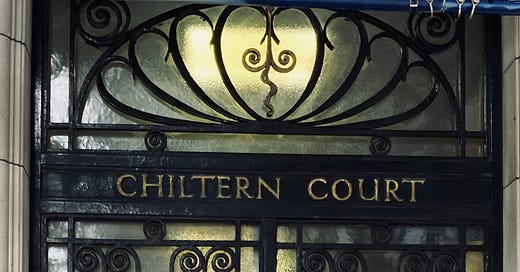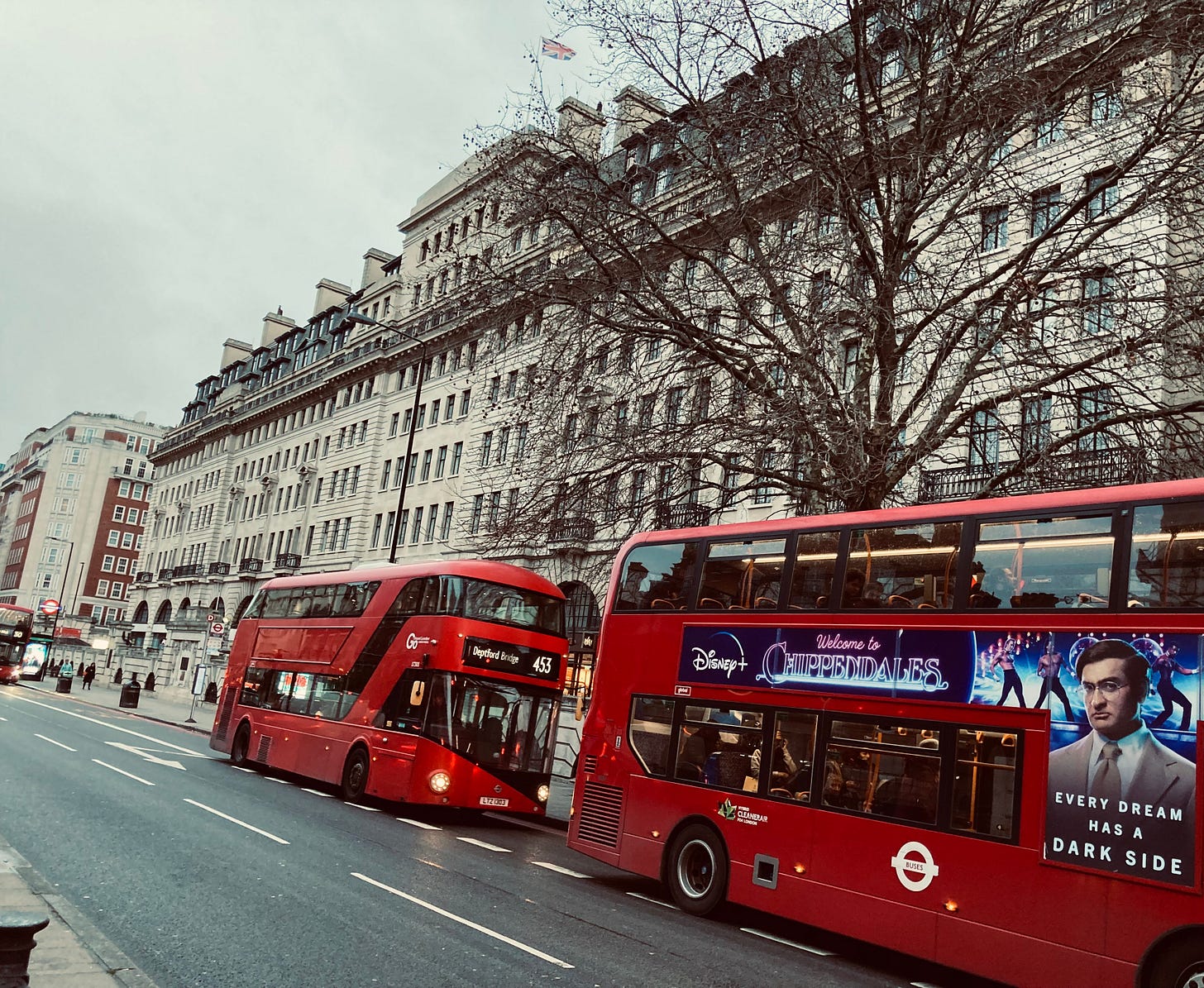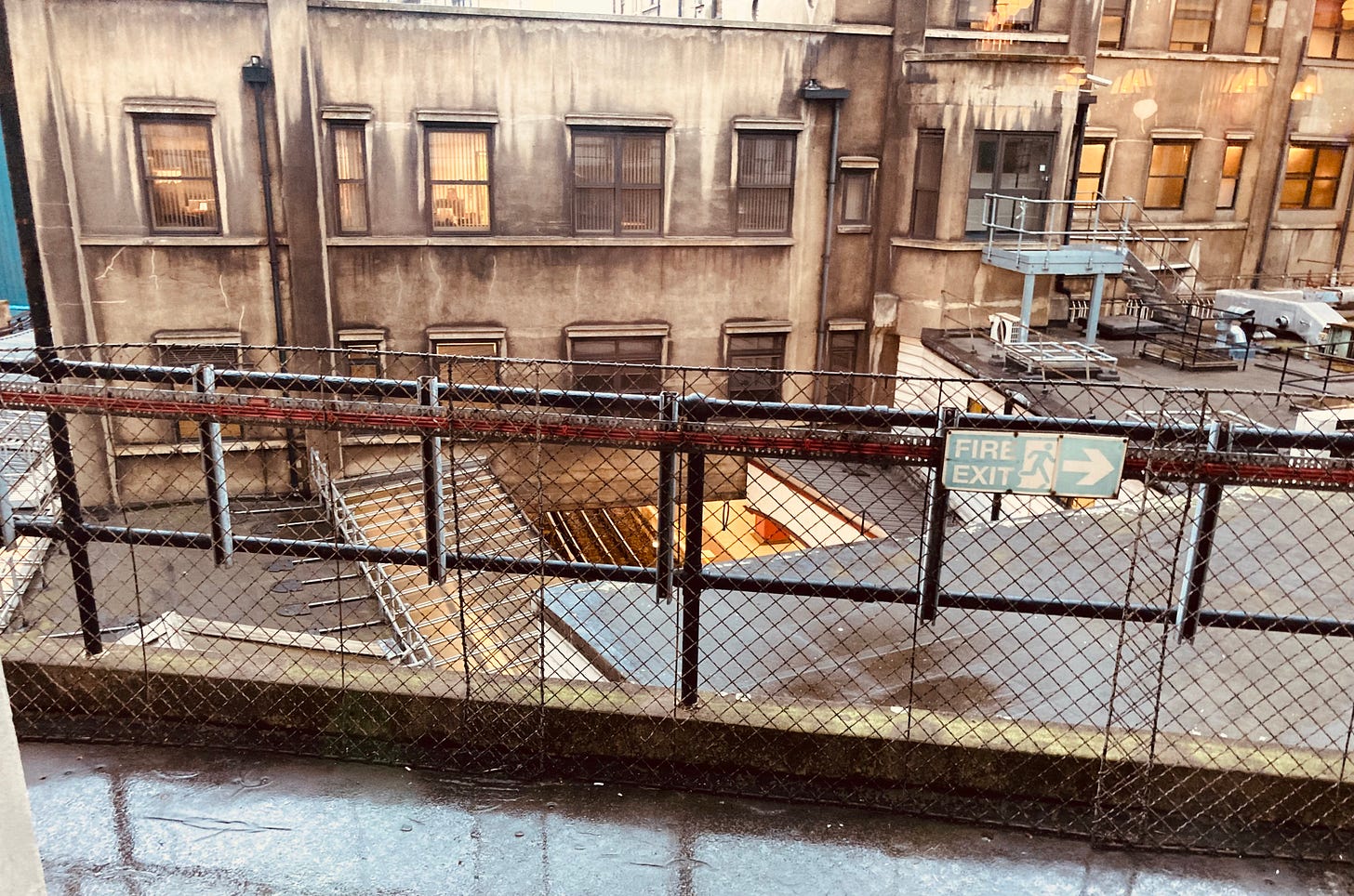At Baker Street station, the gloomy, cave-like platforms five and six once served the first underground line in the world, the Metropolitan Railway. They are (I think) maintained in an artfully gloomy state to give the impression of the gaslight that illuminated them back in 1863 – a rare triumph of theatricality over health and safety. Today, those platforms serve the Circle and Hammersmith & City Lines. The Metropolitan Line still calls at Baker Street, approaching from the City before swerving north along what was called, when it opened in 1868, the ‘Extension Line’, which runs north into Middlesex, West Herts and South Bucks, the territory of the Met’s vast housing development, Metro-land. (‘Child of the first war, forgotten by the second,’ as John Betjeman said in his TV documentary of that name.)
The stately ticket hall at Baker Street dates from 1911 or 1912 (commemorative plaques give both dates), and surely no Edwardian would ever have believed that the facilities denoted by the stone-carved words ‘Luncheon & Tea Room’ would ever disappear, only the words themselves remaining. The ticket hall was created as part of a rebuild of the station by the Met’s architect Charles Walter Clark. After the First World War, he rebuilt several Met stations in an easy-going neo-classical style, and I wouldn’t mind having his Great Portland Street as my own local station.
By the way, a reader of my book on the Underground once wrote to me, condemning the advertising of motor cars on the Tube. I wish I’d know at the time – because it would have been fun to stoke his ire – that one of the retail spaces in Great Portland Street was given over to a car showroom, nearby Warren Street being a centre of the motor trade. (Bernie Ecclestone cut his teeth in Warren Street, I believe.)
Clark was also responsible for the giant block of flats built on top of Baker Street in the late 1920s, Chiltern Court. This was, and still is, described as ‘luxury’, which is no doubt why three of the eminent gents we are concerned with here – Arnold Bennett, H.G. Wells and composer Eric Coates – moved in during its opening in year, 1930. (The fourth, TV host Hughie Green, moved in some decades later.)
In his excellent book, London Underground by Design, Mark Ovenden speaks of ‘200 flats of the highest modernity. It was a valiant effort and ahead of its time in the provision of refuse-collection, pre-cabled phone and radio points.’ There was also, I learnt from the equally enlightening District Dave’s Forum, a railway siding beneath the complex to bring coal and take away ash – this siding being in addition to the half dozen tracks of the Underground, of course.
But I have never seen anyone walk out of Chiltern Court and descend to the Underground. Surely, given the cost of the flats (£1.2m for a two-bed today), they would be more likely to step into Baker Street and hail a cab? But then I’ve never seen anyone walk in or out of Chiltern Court full-stop. The block is generally mysterious to me, one imponderability being why anyone would want to live directly above a Tube station. Is not the rumble of Tubes passing below usually considered a blight?
But perhaps – whether or not you actually used the Tube – you would live in Chiltern Court because you were keen on trains? Because you liked to watch them from your luxurious flat, for example? You can see the Extension Line from the rear of the block, there being a gap in the canopy over those lines. You get this same view from the rear windows of the Metropolitan Bar, a Wetherspoon’s pub that was once the dining room of Chiltern Court and is gratifyingly stuffed with Met Railway memorabilia and has white-globe lights, just as the early Met platforms did.
Arnold Bennett moved into Chiltern Court in November 1930, the lease on his house in Cadogan Square Belgravia, having expired. It seems to have been on the recommendation of his best friend, H.G. Wells, who had already moved in. In her biography of Bennett, Margaret Drabble writes that he was given a tour of the block shortly after it opened by ‘the architect’ (presumably Clark), who assured him that, when it was fully complete, there’d be no sound from the Underground below. Bennett, according to Drabble, fitted-out the flat in a modern style. His study, with ‘hundreds of yards of modern steel shelving’, was decorated in ‘delicate shades of pale beige, silver grey, yellow and grey-brown, a scheme designed by Marion Dorn’ (who would go on to design moquettes for London Underground).
That Bennett had been worried about Tube noise might suggest he was no sort of rail enthusiast, but he had written beautifully about railways, even if his depictions were sometimes of traumatic scenes. His novel of 1923, Riceyman Steps, set in the picturesquely impoverished Clerkenwell of a few years before, features a description of the moment when the excavation of the Metropolitan Railway caused the crown of the Fleet sewer to break: ‘Then the great brick pier, fifty feet in height, moved bodily. The whole bottom of the excavation moved in one mass. A dark and fetid liquid appeared, oozing, rolling, surging, smashing everything it its restless track, and rushed into the mouth of the sewer tunnel.’ The memory brings on a fatal stroke in the old man who tells the tale. (I myself always think the Fleet is going to burst out of the giant pipe that carries it over that gothic cutting between King’s Cross and Farringdon, but then, as I mentioned in Reading on Trains Number 26, I suffer from submechanophobia.)
There had been a gentler evocation of the Underground in his Bennett’s first novel, A Man From the North, which features a description of Putney Bridge station shortly after it opened in 1880. The eponymous Richard Larch has been paying a social call in Fulham. ‘It was necessary to wait for a train at Parsons Green. From the elevated platform fields were visible through a gently falling mist.’ A porter is ‘leisurely lighting the station lamps.’ Larch is taken aback by an illuminated signal coming to life down the line, which ‘might have been a lighthouse seen across unnumbered miles of calm ocean. Rain began to fall.’ I like the way the young arriviste is dazed by the quietness of London, as well as its din.
On 6 July 1911, Bennett went to visit Wells in Pont de l’Arche in Normandy; his French train crashed on the way, and he wrote about the event several times. His account from the Cambridge Review of October 1920, is quoted in Arnold Bennett: Sketches for Autobiography, edited by James Hepburn: ‘Then just after we passed Mantes station there was a really terrific jolting. I knew after four or five jolts that one coach at any rate had left the rails…The windows broke. The corridor door sailed into the compartment…’ Fifteen years later, Bennett used the event as the crux of his novel, Accident, which Ian Carter, in Railways and Culture in Britain, calls ‘a significant railway novel’, a claim we will be examining in a later post (when I have read it).
Bennett, like Wells, was often in France, and on a visit to Paris in late 1930, he drank tap water, as opposed to Evian, so contracting typhoid, from which he would die in Chiltern Court on 27 March 1931. As he descended into delirium, he was indeed tormented by the noise of the Underground, and of the road, where straw was laid down, to mute the traffic, apparently the last time that courtesy was extended to an individual by a public authority. If Bennett had recovered, he would perhaps have written some dreamlike meditation on the contrast between one man’s stasis and the movement all around him.
H.G. Wells had moved into Chiltern Court in August 1930, as part of a rationalisation of his affairs (sexual and financial).
Keep reading with a 7-day free trial
Subscribe to Reading on Trains to keep reading this post and get 7 days of free access to the full post archives.






